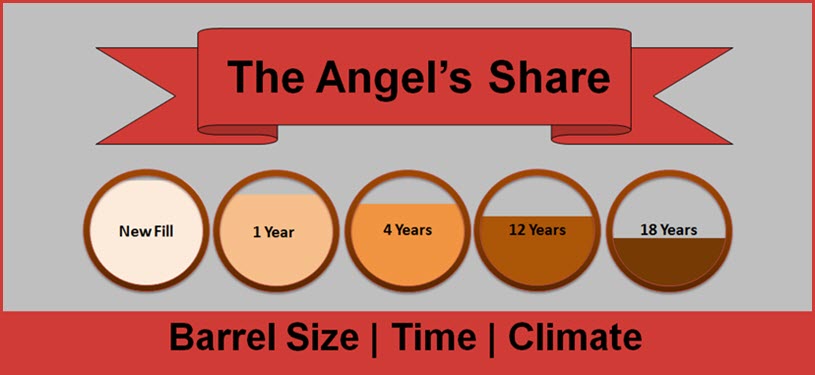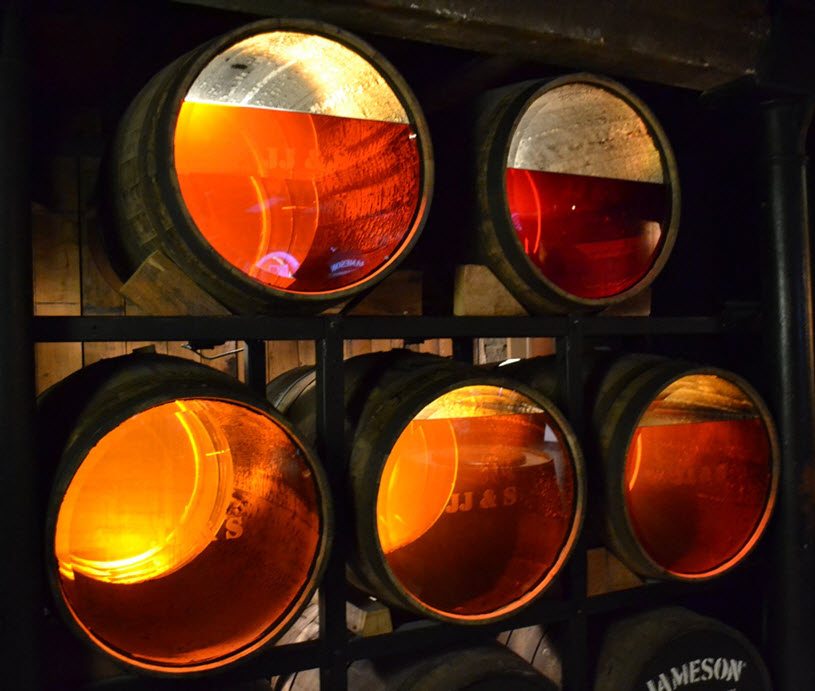
The Angel’s take their cut from every barrel of distilled spirits. It may be a little or it may be a lot but they will not be ignored. In the simplest of terms, the Angel’s Share is the amount of distilled spirits lost to evaporation from the barrel or cask into the air as the whiskey ages. This is often thought of when talking about whiskey or bourbon but the same is true for Scotch, Brandy, Cognac, Wine and Whisky without the e (the Angel’s don’t care how you spell it, they’ll get their share either way.)
Wood is a porous material that expands and contracts with the seasons. Think about the house or apartment you live in. Do you have a door that occasionally sticks? When you stop to think about it, it doesn’t stick all the time, it only sticks in the summer when the humidity tends to be higher. In the winter that same door works just fine. Or maybe you have a wood floor that swells so much in the summer it sometimes buckles, however in the winter you can see small gaps between the boards. This same expansion and contraction happens with wooden barrels as their precious cargo magically matures inside.
The amount the Angel’s take each year varies widely based on barrel size, time, environmental conditions and even the location in the warehouse.
Stay Informed: Sign up here for the Distillery Trail free email newsletter and be the first to get all the latest news, trends, job listings and events in your inbox.
Size: Do the Angel’s Prefer 5, 10, 15 or 53 Gallon Barrels?
As a matter of fact, size does matter. At first thought, you might assume the larger the barrel the faster the evaporation rate. In fact, it’s the opposite, the smaller the barrel the faster the evaporation rate because there’s more liquid by volume in touch with the wood which is in touch with the air which draws the Angel’s Share out of the barrel.
Climate: Are the Angel’s as Greedy in Kentucky as they are in Scotland?
One year maturity in a warm and humid climate like Kentucky is completely different than one year in a milder climate like the Isle of Islay. Scottish distillers are allowed to write off 2% of their production volume each year to the Angel’s Share. When it comes to Kentucky Bourbon or Rye or Tennessee whiskey their Angel’s Share may average closer to 4% and could be as high as 10% in the first year. A good portion of that 10% number is actually absorbed into the staves of the barrel in year one. With Kentucky recording average summer highs of around 89°F compared to 66°F in Scotland, both the level of evaporation and rate of maturation are greatly accelerated. It’s believed that if two exact barrels of liquid were placed in Scotland and Kentucky at the same time, the barrel in Scotland would have to remain there for around three years to equal just one year in Kentucky. This is a good example of not judging a whiskey merely by the age on its label. Maturity does not necessarily equal age.
Location: Does the Floor in the Warehouse Make a Difference?
The style of warehouse and the location in the warehouse also greatly affects the Angel’s Share and many other characteristics of the final product. The heritage bourbon distillers in Kentucky tend to use the 9 story, 27 barrels high warehouses. The atmosphere at the top of a rackhouse is very hot and dry, allowing the water molecules to escape much faster than the alcohol molecules thus driving the proof up in those barrels and concentrating the flavors inside the barrel. The atmosphere at the bottom of the rackhouse is moist and cool. Since a water molecule is very small, water can penetrate the barrel from the surrounding moisture and that drives the proof down to around 110 in those barrels. You can learn more about how the Location in the Warehouse Effects Proof here.
A whiskey barrel could lose 30% to 40% of its volume between the original barreling and the time the liquid is ready for bottling. Some distilleries will provide the details of how much of their precious cargo is lost to the Angel’s while others choose to keep it a secret just like their yeast recipe. Check out this detailed report from a recent release of the Antique Collection from Buffalo Trace Distillery. It’s the kind of details that whiskey aficionados can’t get enough of.
There is no single answer to how much is lost each year. Other variables include the entry proof of your spirits into the barrel. Spirits barreled at 125 proof have a higher alcohol vs. water ratio than spirits barreled at say 103 proof. Low humidity and higher temperatures will draw more water through the staves resulting in higher alcohol content. And, higher humidity will result in more alcohol evaporating than water.
As your variables change, so will your results. The key is to keep good records and you’ll continue to produce consistent distilled spirits. The same applies to your experiments, always keep good records so those results can be repeated.
You are never really going to know the Angel’s Share vs. your share until that glorious day you pop the bung out of the barrel and start filling your bottles!
Related Stories
Buffalo Trace Distillery 2015 Antique Collection Whiskeys by the Numbers – Evaporation loss from these releases varies from a low of 30% for a 6 year old bourbon to a whopping 84% for a 15 year old.
Part 1: Understanding Oak Barrel Maturation – Know Your Casks
Part 2: Understanding Oak Barrel Maturation – Maturity is Not Age
Part 3: Understanding Oak Barrel Maturation – Location, Location, Location
Jameson Whiskey Barrels – New Fill, 3 Years, 4 Years, 12 Years and 18 Years

Please help to support Distillery Trail. Sign up for our Newsletter, like us on Facebook and follow us on Twitter.




